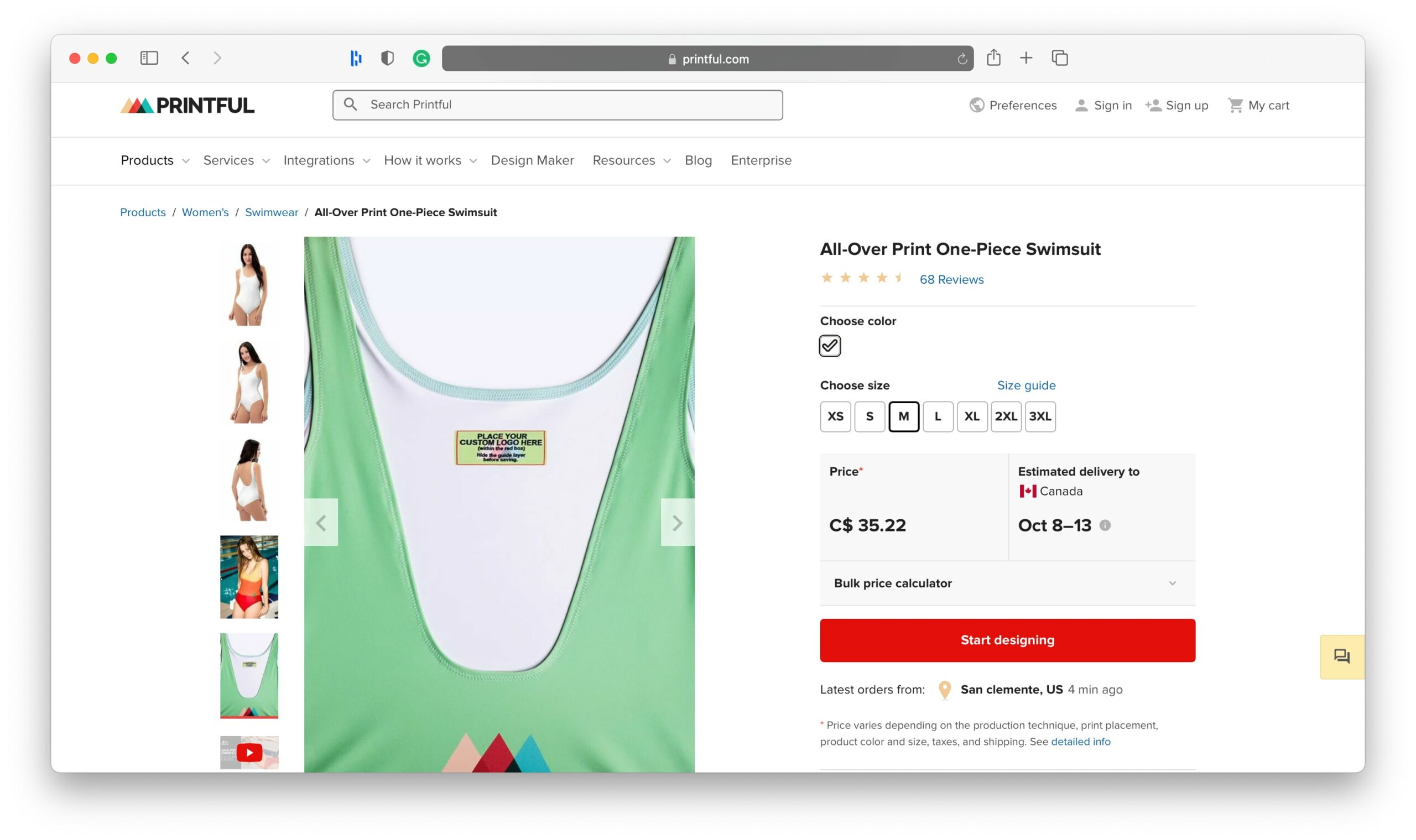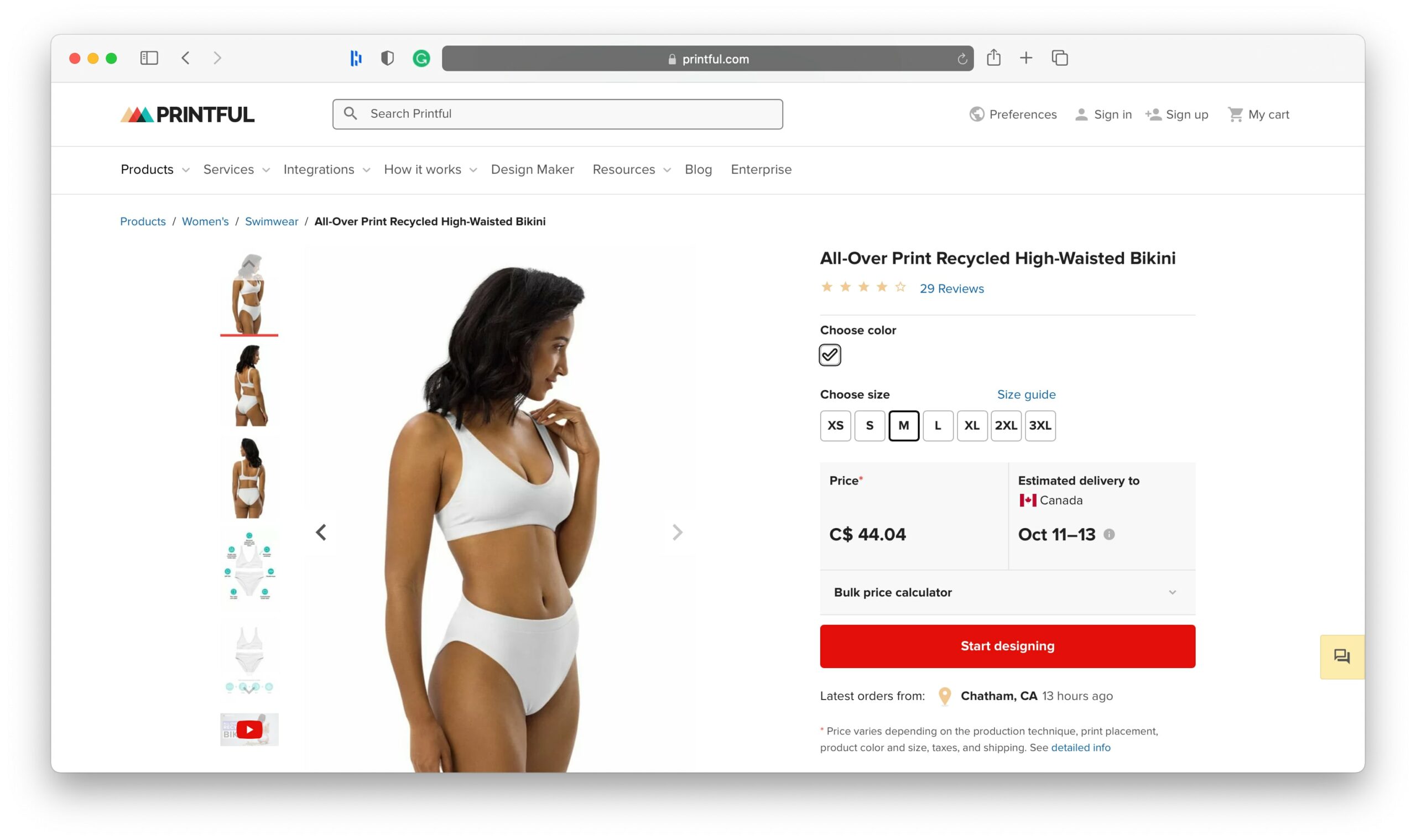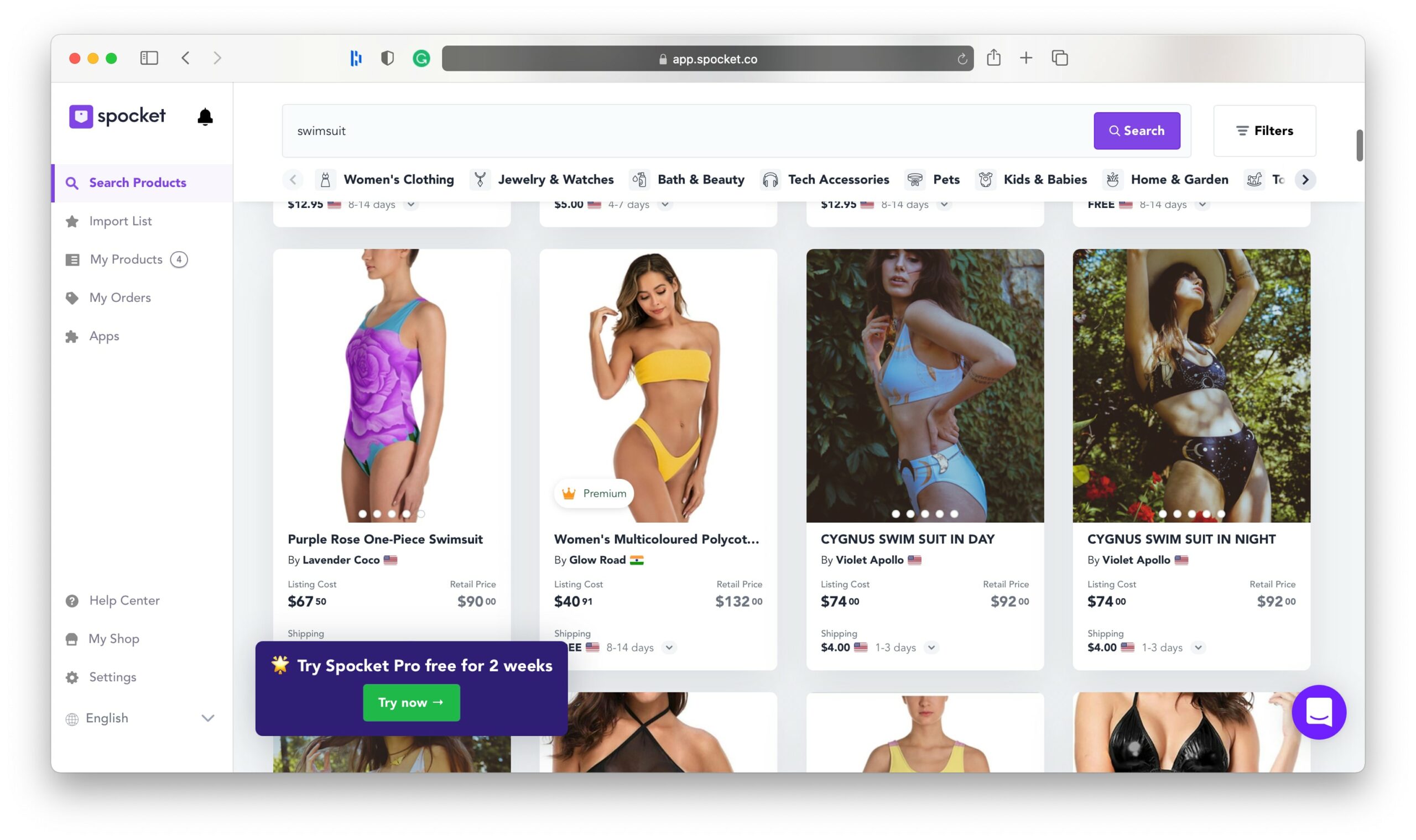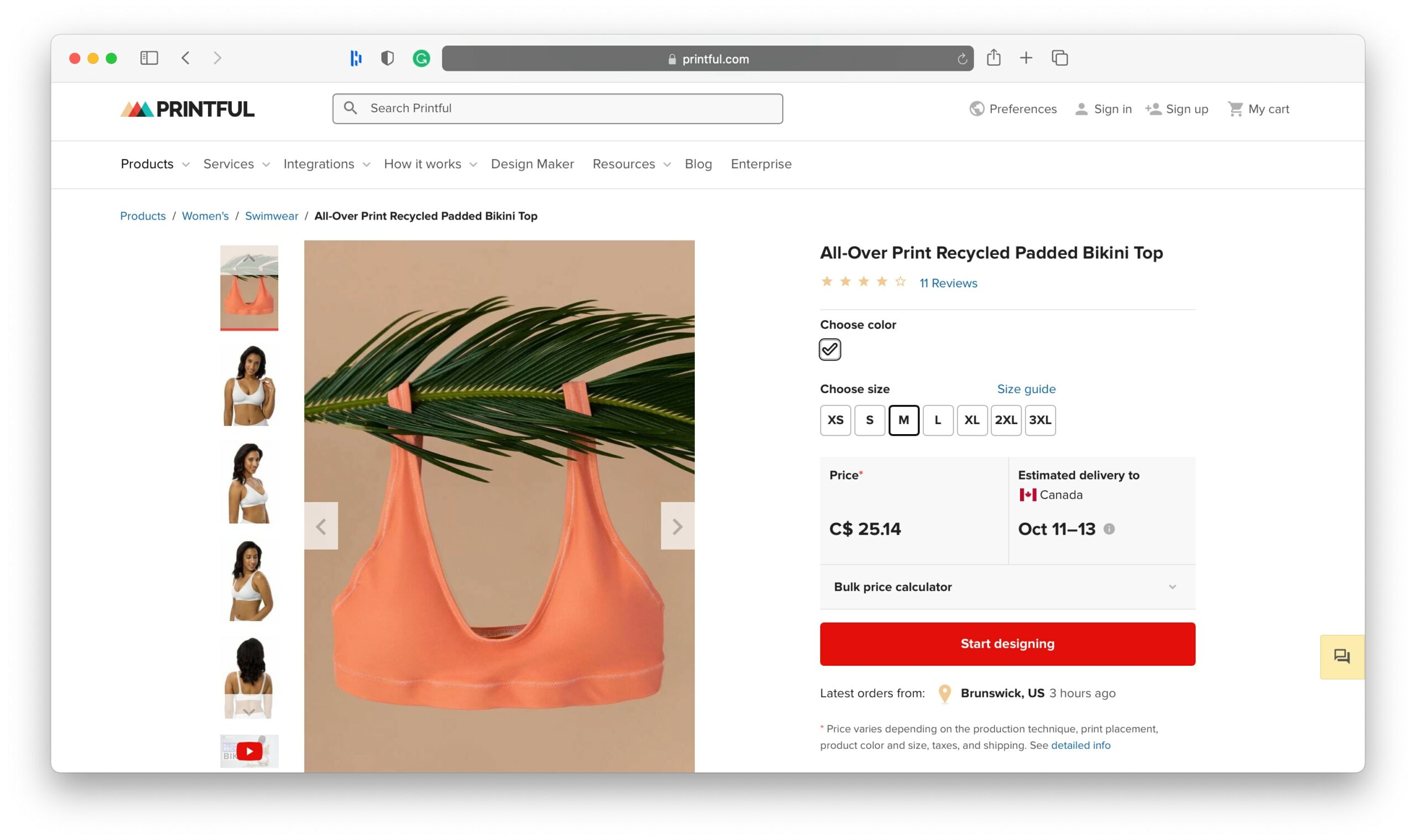
How to Start a Swimwear Brand
Travel plans were hugely impacted in 2020, but global airline statistics show that consumers are once again starting to take to the skies. For many, this means traveling to tropical locations to work on their tans. The excitement to get out in the sun is infectious, so it’s no surprise that swimwear is very much in demand.
If you’re a lover of sporty swimwear and fashionable bikinis, you may even consider turning this passion into a business. Swimwear is a massive industry that will likely enjoy a considerable boost as travel sets back into motion — so now’s the time to transform your dreams into a reality.
In this article, we cover everything you need to know about how to start a swimwear brand. Specifically, we’ll take a look at whether it’s a good idea for you, who you could sell to, and what you need to know about the manufacturing process.
There’s a lot to cover, so let’s get started!
Why Start a Swimwear Brand?
Swimwear is a fun and exciting niche to enter into; there’s something to be found for everyone and plenty of opportunities to get innovative. Swimwear also isn’t just great for athletes, it’s a chance to celebrate those sunny summers and warm days spent together with friends and family.
From a business standpoint, swimwear’s a noteworthy industry. The global market value for swimwear has steadily increased and is predicted to hit 29.1 billion US dollars by 2025. And, during the pandemic, swim and activewear became increasingly popular — likely due to so many people realizing the importance of exercise as well as the great outdoors.
Like any facet of the fashion industry, swimwear is also an exciting way to let your creativity shine while capitalizing on rising trends. For example, in recent years we’ve seen the introduction of neoprene fiber for better elasticity. The market has also become more sustainable and diverse. Many consumers are also looking to buy from smaller brands which is unlocking the opportunity for new brands to compete with well-known names.
Finding a Niche
Although there’s a big demand for swimwear from small, innovative brands, it also means that there’s a lot of competition. So, to succeed, you’ll have to stand out from the crowd and bring something truly unique to the table.
That’s why it’s vital to understand which niche you want to sell to before you start designing your products and launching your business. Luckily, the swimwear industry has quite a few niches you could dive into (no pun intended).
- Active Swimwear: Although swimwear isn’t just used for sports alone, sporty styles are also in fashion. Comfortable swimwear that lends itself to exercise is a popular niche worth exploring.
- Body-Positive Swimwear: Just as we’ve seen a shift in underwear marketing to include more diverse body types, swimwear is much the same. If natural bodies and body positivity is important to you, this could be your top niche and value proposition.
- Modest Swimwear: This is a small by mighty niche that could be of interest if it aligns with your values. This swimwear features longer cuts, cover-up garments, or even clothing that can be comfortably worn in the bath.
- Sustainability: One of the many swimsuit fabric innovations of recent years is fully recycled fabrics. Other fabrics on the market today are quicker to dry, withstand sun, chlorine, and saltwater. They won’t break down anywhere near as quickly as they used to which helps to keep swimwear out of landfills. If you care about sustainability, this could be a niche worth considering.
Aside from finding your niche, you may also want to keep a close eye on current swimwear trends. Of course, these dictate what sells well to the masses, but bear in mind that most competitors will have the same idea, so you’ll still need to find ways to differentiate yourself from your competitors.
Where to Sell Your Swimwear
The best place to start a swimwear brand is online, where you don’t have the costs of a brick-and-mortar store to worry about. That said, there are dozens of online ecommerce platforms where you could sell your products.
For most start-ups in the swimwear industry, Shopify (Shopify Review) is the ideal solution. Shopify is a subscription-based ecommerce platform that allows you to easily create and customize an online storefront. Shopify provides all the features you need to manage your inventory, create product variations, optimize your store for SEO, organize your shipping, and more. There are also plenty of Shopify themes you can use to extend the functionality of your store — many of which are explicitly designed for fashion and apparel brands. Shopify starts at $29 per month and easily scales with your business as you grow.
About Swimwear Manufacturing
Now that you’ve gotten this far, it’s time to figure out where to source your products from. You could either find a print-on-demand company to print your own designs, work with a wholesale swimwear brand, or find a manufacturer to design your own swimwear line.
Regardless of which option is right for you, it’s worth knowing more about the manufacturing process. So, we’ll briefly cover what goes into creating swimwear in the following sections.
Specialist Fabrics
When it comes to designing a successful swimwear line, understanding the fabrics is essential. Swimwear has to withstand chlorine and sunscreen, it also has to be stretchy but able to return to its original form to continue to hug the body. These criteria don’t just apply to the main surface of the swimsuit either; lace, fastenings, and decorative trims all have to meet the same standards and can’t deteriorate when exposed to sun, salt, chlorine, and water.
The majority of swimwear fabrics are manufactured in Italy and contain 20% lycra or elastane for elasticity. Other components include nylon, polyamide, or polyester. That said, there are three main variants used worldwide:
- The cheapest is made from 20% elastane and 80% polyester
- The second uses 80% nylon instead, which is a lot stronger and more durable
- Finally, there’s a variant with 53% polybutylene terephthalate (PBT) and 47% polyester. This enjoys the highest chlorine resistance (270 hours of resistance compared to 160 hours for other blends)
Performance vs. Leisure
It’s also worth bearing in mind that there are two significant types of swimwear for apparel manufacturers.
- Leisure swimwear
- Performance-based swimwear
Leisure swimwear is for beaches and poolsides. These garments are designed to be lounged around in and are best suited for sun-bathing and the occasional leisurely swim. For leisurewear, it’s vital that fabrics hold onto their shape and color and can withstand chlorine and seawater.
In contrast, performance-based swimwear is intended for swimming professionals and those swimming at great lengths for exercise. Therefore, performance-based swimwear must resist snagging and fading and provide an exact fit to the body.
Manufacturing Requirements
Most swimsuits are made with overlock machines, which create the distinct seams we associate with knit fabric garments. The stitch from an overlock machine appears as a zig-zag and is composed of three looping threads. This allows for lots of stretch, making it perfect for swimwear.
Manufacturers specializing in swimwear are also likely to have on-trend swimsuit patterns that are comfortable to wear. They might also have in-house custom fabrics that can add more value to your products.
The bottom line is that swimwear manufacturing differs significantly from other apparel so when searching for the right manufacturer to work with, try to find one that specializes in swimwear.
Starting a Swimwear Brand
How to Dropship Swimwear
If manufacturing your own swimwear line isn’t for you, the easiest and quickest way to source swimwear is via the dropshipping business model. This way, you just select the products you want to sell from a dropshipping supplier like Spocket and start selling them on your website. Alternatively, you can use a print-on-demand company like Printful. With them, you can submit your own designs to be printed on their swimsuits.
Printful, for example, offers all-over print bikinis, high-waisted bikinis, swimsuits, and more. They even sell recycled bikinis if you’re looking to launch a sustainable swimwear brand. Just create an account, import the products of your choice, and link them to one of your designs. Since Shopify integrates with Printful and other dropshipping suppliers, you can get selling in no time.
The best part is that no matter which dropshipping supplier you choose, whenever a customer purchases from your website, the order is automatically sent to your dropshipping partner, who then makes, packs, and ships the item directly to your customers. You don’t have to do any of the work, your dropshipper handles it all for you!
Dropshipping doesn’t require you to invest any money in inventory or warehousing and is, therefore, the least risky business model for new entrepreneurs. However, the profit margins are often much smaller — so that’s the tradeoff.
Bear in mind that thousands of other businesses also have access to these dropshipping suppliers. Therefore, the cuts and fabrics will be the same as hundreds of others, so you’ll have to get a bit creative with your marketing. If you’re hoping to innovate on materials or shapes, dropshipping might not be the solution for you.
It’s also worth noting that it’s challenging to offer customers consistent sizing if you’re dropshipping products from different suppliers. The ready-made styles might turn out smaller than expected, especially from Asian suppliers. This can make it difficult to provide accurate size guides across your range.
How to Source Swimwear from Wholesale Brands
If you’re up for more of a challenge and are looking for a much better profit margin earning potential, you might want to talk to swimwear manufacturers directly. You might be surprised how cheap it actually is to get a $100 swimsuit made; the swimwear industry has some of the best profit margins out there.
There are two types of swimwear manufacturers to choose between:
- One option is to speak to a manufacturer directly and create custom swimwear designs (more on this later)
- The other option is to find a wholesale brand that sells white-label products. This is similar to the dropshipping solution in that other businesses will also have access to the same products
Each season, factories create a bunch of designs, and you can purchase whichever ones you want to stock your store with. The best part about sourcing from a wholesaler is that you don’t have to do any of the design or manufacturing work, you just have to select what you like and purchase it from the supplier.
But, unlike dropshipping, you’ll have to order your stock before you sell it. This means a larger initial investment is required, and you’ll need to store and ship your own products.
To hit the ground running, you can find a list of wholesale suppliers here.
How to Get Swimwear Manufactured
Another option we’ve hinted at is the ability to manufacture your own unique designs. This entails finding a swimwear manufacturer to work with you on creating custom patterns, prints, and maybe even fabrics.
Out of all the ways to source swimwear, this is the most complex and expensive. You’ll need to research your options carefully, speak at length with potential suppliers, and be willing to invest heavily in your business. Many manufacturers require a minimum order quantity to make the partnership worth their while.
If you’re a creative person with unique ideas and have an audience to sell to or a lump sum to invest in a business, then this is a great option for you. It means that your products will be unique to your brand, which can help you stand out from the crowd and make a name for yourself in the industry.
If manufacturing your own swimwear line is of interest to you, browse our clothing manufacturer directory here.
Product Sourcing Best Practices
Now you know what options are available to you when it comes to sourcing swimwear.
However, there’s a wide range of manufacturers and suppliers to choose from, making it challenging to find the best fit. That said, here are a few tips on how to pick the best option for you:
- Ask for Samples: Whether you’re working with a dropshipping platform or a private manufacturer, always order a sample first for quality control purposes. This enables you to check that the colors of your design work well on the fabric and that the tags, labels, seams, comfort, sizing, and that everything else is up to par.
- Ethical Sourcing: Educate yourself on what your supplier’s factory is like. Are employees paid a fair wage? Are they working in fair and humane conditions? If you’re working closely with a manufacturer, it might even be worth giving their factory a visit. Knowing your manufacturer’s values is essential if responsible product sourcing is essential to your brand.
- Sustainability: Does the factory offer sustainable products? Recycled swimwear fabrics are just the first step. You can also ask if they use clean energy, whether they filter and recycle their water, and how they process scrap material.
- Communication: Some dropshipping platforms make it challenging to communicate with suppliers directly, but if you want more control over your brand’s products, you might want to cut out the middleman. So, find out who you’ll speak to if an issue arises. Is support fast and helpful? Can you get in touch with the manufacturers directly? Etc.
The Pros & Cons of Starting a Swimwear Brand
Are you ready to tackle your vacation-wear dreams? Before deciding to start a business, you need to weigh out the pros and cons for yourself. Unfortunately, we can’t do that for you, but we can summarize the pros and cons of starting a swimwear brand to help you come to a decision:
The Pros:
- Swimwear is in high demand, and the industry is only expected to grow in the next few years
- Done well, swimwear boasts a lucrative profit margin
- Swimwear is small and light, making it easy to store and ship
- Print designs on swimwear are a popular trend. This is the perfect opportunity to let your creativity run wild
- The industry features a range of innovations, making it an exciting market to be a part of. Customers are looking for more sustainable, diverse, functional, and comfortable swimwear, and manufacturers are rising to the challenge
- Swimwear is easy to source from dropshippers and wholesalers. Still, you can also work with manufacturers on creating unique products — the choice is yours!
- It is possible to source sustainable swimwear
The Cons:
- Because of its high demand, swimwear is one of the most popular industries for start-ups and entrepreneurs. As such, you’ll be facing intense competition, so finding a unique selling point is vital
- Swimwear sales may be affected by seasonal swings. When winter comes around, fewer customers are looking for new swimwear products
Are You Ready to Start Your Own Swimwear Brand?
A new business brings with it new challenges, and the swimwear industry is no different. Nonetheless, entrepreneurs are seeing potential in swimwear. So whether you want to create that vacation feeling all year round or find an outlet for your creativity, selling swimwear could be the solution. We hope this guide has provided you with the information you need to take your ideas further.








